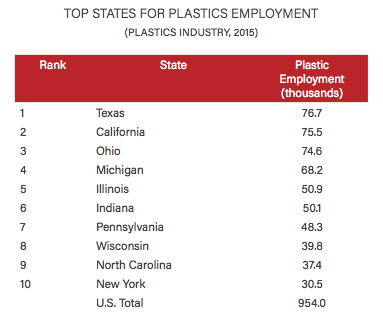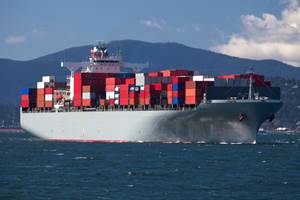Plastics Industry Association Sees Strength in Numbers
The Plastics Industry Association discussed a new report on the size and state of the U.S. plastics industry against the backdrop of new political leadership in Washington.
While the total shipments and shipments value of the industry both dipped slightly—2%—association president and CEO, Bill Carteaux, said the report reflects a relatively young industrial sector that continues to outpace the broader manufacturing space. Carteaux also noted that the Plastics Industry Association has been among those in talks with President-Elect Trump’s transition team, giving him further optimism regarding the industry going forward, particularly since, in general, the association’s goals are more broadly in line with Republican policies as compared to Democratic.
On Jan. 17, the National Association of Manufacturers (NAM) announced that Carteaux would serve as chair of the NAM’s Council of Manufacturing Associations (CMA) for a one-year term, with Chris Jahn, president of The Fertilizer Institute, serving as vice chair.
“On the heels of the arrival of a new Congress and, soon, a new Administration, the Size & Impact Report shows why the plastics industry will be such an important part of the effort to support job growth in manufacturing,” Carteaux stated in a release. “The plastics industry is ready to work together with Congress, the Administration and its partners to lead American manufacturing into a new golden era.”
Using the most recently available data for the year 2015, the report found that the U.S. plastics industry accounted for $418.4 billion in shipments that year and 954,000 jobs. The employment figure marked a 1.4-percent increase over 2014. When suppliers to the U.S. plastics industry are included, total shipments value climbs to $571.5 billion, while jobs rise to 1.75 million.
Compared to 2014, the 2015 shipments were down 2% in total and value terms. This was largely the result of lower prices in plastics feedstocks, like oil and natural gas, impacting resin prices, so that the decline in shipment value didn’t equate with a decline in demand.
Apparent consumption set another record in 2015, reaching $295.4 billion, with that figure showing a steady increase since its most recent nadir in 2009. That follows recent trends for apparent consumption in plastics. In trade, it was another very good year for plastics which enjoyed a surplus at $7.1 billion, derived from total exports just shy of $60 billion. A particular area of strength was molds, were exports jumped 10% to $582.2 million. Meanwhile, machines (down 9.7% to $1.4 billion) and resin (down 8% to $32.4 billion) showed declines. The overall plastics business trends remain in line with previous years.
Plastics Employment Outpaces Manufacturing; Big Gains in Moldmaking
Plastics employment was up 1.4% in 2015 over 2014 to 954,000 workers. After bottoming out in 2009 at around 870,000, the industry is making the slow climb back to 1 million employees. If you include suppliers in the figure, total employment rises to 1.75 million, which was up 3%. Going back to 1980, employment in plastics manufacturing grew 0.3 %/year, while employment in all U.S. manufacturing dropped 1.2%/year.
Plastics has also outpaced broader manufacturing in productivity gains, albeit just slightly, rising 2.1%/year, from 1980 to 2015, while manufacturing as a whole rose 2.0% annually. Carteaux noted that in general plastics has been less affected by automation and globalization trends than many of its industrial counterparts.
The productivity gains come into stark relief when employment is measured against shipments value. In 1999, the U.S. plastics industry reached peak employment at 1.035 million workers, before embarking on 10 straight years of contraction beginning in 2000. The value of shipments today, however, is more than 12% higher than 1999, coming in at $302.7 billion in 2015 compared to $269.9 billion in 1999. Shipment value peaked in 2006 at $310.8 billion.
Looking at the Federal designation for tooling—Molds for plastics (NAICS 33351105)—the total number of businesses dropped 7.9% from 2005 to 2010. From 2010-2015, however, that contraction slowed to 1.1%/yr. Number of employees, meanwhile, flipped from shrinking 9.2% per year from 2005-2010, to growing 5%/year from 2010-2015.
Employment By State
In terms of total employees, Texas overtook California to become the largest total employer for plastics, with 76,700. In terms of concentration as measured by plastics worker for every 1000 non-farm workers, Indiana was number one at 16.5, followed closely by Michigan with 16.1 plastics workers for every 1000 non-farm laborers.
The association’s numbers also displayed a continuing shift in employment during the decade covering 2005 to 2015 with the most dramatic movements occurring in the Northeast and the Southeast. In terms of total employees, the biggest riser was Alabama climbing six spots from No. 22 in 2005 to No. 16 in 2015. The biggest drops happened in New Jersey and Massachusetts, falling five spots each from No. 12 to No. 17 for New Jersey and from No. 14 to No. 19 for Massachusetts.
In terms of concentration, Alabama soared 12 spots, from No. 19 to No. 7, while New Hampshire and Mississippi both dropped nine slots, moving from No. 8 to No. 17 for Mississippi and from No. 13 to No. 22 for New Hampshire.
Related Content
Recycled Plastic Flooring Product Recognized
Shaw industries recognized by Fast Company for its PET flooring product.
Read MorePackaging Waste Will Become Composite Decking
New partnership will incorporate process waste into wood-alternative decking.
Read MoreArtificial Intelligence Enables Smarter Sourcing
Westfall Technik has adopted Arkestro’s predictive procurement software to wring savings and more reliable deliveries from a historically challenging supply chain.
Read MoreRecord Reshoring Rates in 2022
Reshoring and foreign direct investment (FDI) in the third quarter marked their highest ever level, eclipsing the previous record set in the second quarter of 2022.
Read MoreRead Next
Understanding Melting in Single-Screw Extruders
You can better visualize the melting process by “flipping” the observation point so that the barrel appears to be turning clockwise around a stationary screw.
Read MoreLead the Conversation, Change the Conversation
Coverage of single-use plastics can be both misleading and demoralizing. Here are 10 tips for changing the perception of the plastics industry at your company and in your community.
Read MoreProcessor Turns to AI to Help Keep Machines Humming
At captive processor McConkey, a new generation of artificial intelligence models, highlighted by ChatGPT, is helping it wade through the shortage of skilled labor and keep its production lines churning out good parts.
Read More





























